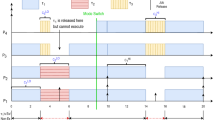Abstract
Gang scheduling (GS) is an efficient scheduling approach for distributed systems. The CompactMatrix is the second phase in GS and plays a main role in accelerating the scheduling of the larger gangs. In this paper, a novel method is proposed to compact the scheduling matrix by using two new ideas. By using simulation, the impact of the proposed ideas was compared to the basic CompactMatrix algorithm, either individually or simultaneously. The results show that the average response time in the Improved CompactMatrix Algorithm (ICMA), compared with the basic CompactMatrix, is reduced about 2 to 20, 0 to 10, and −5 to 5 percent by selecting the migration overhead values equal to 5, 10, and 15 percent of the time-slices lengths, respectively. As can be seen, ICMA will show better results in smaller migration overheads.
















Similar content being viewed by others
References
Zomaya A, Chan F (2005) Efficient clustering for parallel task execution in distributed systems. J Found Comput Sci 16:281–299. doi:10.1109/IPDPS.2004.1303164
Feitelson DG, Rudolph L (1996) Toward convergence in job schedulers for parallel supercomputers. In: Proc of the worksh on job sched strateg for parallel process. Springer, London, pp 1–26
Ousterhout JK (1982) Scheduling techniques for concurrent systems. In: Proc of the 3rd int conf on distrib comput syst, pp 22–30
Feitelson DG, Jette MA (1997) Improved utilization and responsiveness with gang scheduling. In: Job sched strateg for parallel process, vol 1291, pp 238–261
Rajaei H, Dadfar M, Joshi P (2006) Simulation of job scheduling for small scale clusters. In: Proc of the 38th conf on winter simul, pp 1195–1201. doi:10.1145/1218112.1218327
Zhou B, Goscinski A, Brent R (2003) Concerning the length of time slots for efficient gang scheduling. IEICE Trans Inf Syst 86:1594–1600
Papazachos Z, Karatza HD (2009) Gang scheduling in a two-cluster system with critical sporadic jobs and migrations. In: Proc symp perform evaluation of comput telecommun syst, pp 41–48
Milojicic DS, Douglis F, Paindaveine Y, Wheeler R, Zhou S (2000) Process migration. ACM Comput Surv 32:241–299
Papazachos Z, Karatza HD (2012) Scheduling of frequently communicating tasks. Int J Commun Syst 25:146–157. doi:10.1002/dac.1260
Papazachos Z, Karatza HD (2010) Gang scheduling with precedence constraints. In: Proc int symp perform evaluation of comput telecommun syst, pp 331–337
Moschakis I, Karatza HD (2012) Evaluation of gang scheduling performance and cost in a cloud computing system. J Supercomput 59:975–992. doi:10.1007/s11227-010-0481-4
Shih W, Lin C, Chang Y, Lee J (2000) Real-time gang schedulings with workload models for parallel computers. J Inf Sci Eng 16:333–347
Wiseman Y, Feitelson DG (2003) Paired gang scheduling. IEEE Trans Parallel Distrib Syst 14:581–592. doi:10.1109/TPDS.2003.1206505
Setia S (1997) Trace-driven analysis of migration-based gang scheduling policies for parallel computers. In: Proc int conf on parallel process, pp 489–492. doi:10.1109/ICPP.1997.622685
Zhang Y, Franke H, Moreira J, Sivasubramaniam A (2003) An integrated approach to parallel scheduling using gang-scheduling, backfilling, and migration. IEEE Trans Parallel Distrib Syst 14(3):236–247. doi:10.1109/TPDS.2003.1189582
Papazachos Z, Karatza HD (2010) Performance evaluation of bag of gangs scheduling in a heterogeneous distributed system. J Syst Softw 83:1346–1354. doi:10.1016/j.jss.2010.01.009
Karatza HD (2001) Performance analysis of gang scheduling in a distributed system under processor failures. Int J Simul Syst Sci Technol 1:14–23
Karatza HD (2006) Scheduling gangs in a distributed system. Int J Simul Syst Sci Technol 7:15–22
Karatza HD (2001) Gang scheduling performance under different distributions of gang size. Parallel Distrib Comput Pract 4(4):433–449
Karatza HD (2006) Performance analysis of gang scheduling in a partitionable parallel system. In: Proc 20th Eur conf model simul, pp 699–704
Karatza HD (2009) Performance of gang scheduling strategies in a parallel system. Simul Model Pract Theory 17:430–441. doi:10.1016/j.simpat.2008.10.001
Papazachos Z, Karatza HD (2009) The impact of task service time variability on gang scheduling performance in a two-cluster system. Simul Model Pract Theory 17:1276–1289. doi:10.1016/j.simpat.2009.05.002
Papazachos Z, Karatza HD (2009) Scheduling gangs with different distributions in gangs’ degree of parallelism in a multi-site system. In: Proc 4th balk conf in inform, pp 121–126. doi:10.1109/BCI.2009.10
Papazachos Z, Karatza HD (2009) Performance evaluation of gang scheduling in a two-cluster system with migrations. In: Proc IEEE int parallel and distrib process symp, pp 1–8. doi:10.1109/IPDPS.2009.5161172
Kavas A, Er-El D, Feitelson DG (2001) Using multicast to pre-load jobs on the ParPar cluster. Parallel Comput 27:315–327. doi:10.1016/S0167-8191(00)00101-0
Papazachos Z, Karatza HD (2011) Gang scheduling in multi-core clusters implementing migrations. J Syst Softw 27:1153–1165. doi:10.1016/j.future.2011.02.010
Zhang Y, Franke H, Moreira J, Sivasubramaniam A (2000) The impact of migration on parallel job scheduling for distributed systems. In: Proc Europar, pp 242–251. doi:10.1007/3-540-44520-X_33
Sodan A, Doshi C, Barsanti L, Taylor D (2006) Gang scheduling and adaptive resource allocation to mitigate advance reservation impact. In: Proc sixth IEEE int symp clust comput and the grid, pp 649–653. doi:10.1109/CCGRID.2006.47
Averill L (2007) Simulation modelling & analysis, 4th edn. McGraw-Hill, New York
Zhang Y, Yang A, Sivasubramaniam A, Moreira J (2003) Gang scheduling extensions for I/O intensive workloads. In: Proc of the 9th worksh on job sched strateg for parallel process
Acknowledgement
The authors would like thank Mr Morteza Mollajafari for his help in revising the first version of this paper.
Author information
Authors and Affiliations
Corresponding author
Rights and permissions
About this article
Cite this article
Amir, H., Shahhoseini, H.S. Improving CompactMatrix phase in gang scheduling by changing transference condition and utilizing exchange. J Supercomput 66, 1707–1728 (2013). https://doi.org/10.1007/s11227-013-0971-2
Published:
Issue Date:
DOI: https://doi.org/10.1007/s11227-013-0971-2




